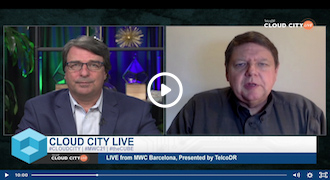
theCUBE Interview: Innovation at the Edge with AWS
AWS talk about the compelling 5G proposition, the rewards it can bring, and the challenges for the telecom operators who want to take full advantage of it.
I talk A LOT about telcos using the public cloud in IT. I think it’s an easy route to the public cloud for telcos to take their old legacy applications, right through BSS and charging, and move those applications to get a ton of TCO savings and feature velocity. But another popular approach is to use the public cloud at the edge. And I think this is a great idea, too.

All of the hyperscalers offer edge capabilities: Microsoft Azure with Azure private MEC, AWS with Outposts, Wavelength and Local Zones, and Google Cloud with Anthos. We compared these offerings in a previous blog if you want to learn more about the differences between the services. But I want to talk about what’s going on with the public cloud and the edge. As we’ve seen over the past few months, there have been a number of high-profile announcements of telcos partnering with the hyperscalers. For example:
Clearly, there’s a lot of demand from major telcos to leverage the power of the hyperscalers at the edge. But why use the public cloud at the edge? What’s the advantage? Let’s start by looking at the alternatives if you DON’T use the public cloud.
There are two alternatives available to telcos when it comes to building their own non-public cloud edge infrastructure:
To start, you need to look at the edge through the eyes of the user: enterprises and consumers. For enterprises, hyperscalers offer a tech stack that they know and love, and many are already using the public cloud in other areas of their business. Their employees already know how to create apps using the public cloud, so building at the edge (using the AWS stack, for example) taps into their existing knowledge without requiring the hassle, cost, and additional hours of learning a new, proprietary approach. They can quickly build the applications they need.
While most people look at the public cloud as an INFRASTRUCTURE play, they need to look at it for what it’s towering strength is: its SERVICES. The public cloud is a plug-and-play platform that saves time and money on creating applications. AWS, for example, has more than 160 services that act like Lego building blocks for enterprise applications. This brilliant song from A Cloud Guru’s Forrest Brazeal is testimony to the breadth of services AWS offers. The other hyperscalers have a similar set of services.
The alternative approaches – using a proprietary stack or working with a fake cloud provider like Oracle – forces your enterprise customers to learn an entirely new stack, complicating the app development business and slowing time to market for new services. These customers are ALREADY picking the public cloud themselves for their internal IT. Telcos could just jump on this bandwagon. If you don’t believe me, just ask any telco’s VP of Enterprise Sales which is easier to sell: developing against the AWS/GCP/Azure tech stack, or some proprietary one? I’ll tell you right now – it’s the BFCs.
It’s not just the enterprise that is set to be transformed by the capabilities of the telco edge. Consumer applications will also get the same makeover by bringing processing power closer to the end-user.
Consider live sports and the fan experience: By leveraging the power of 5G edge computing and partnering with a hyperscaler, a telco could identify season ticket holders, VIPs, and employees, and automatically authorize them to enter a stadium faster (as discussed here by Verizon). No more long lines to get into events. Telcos could also transform the live viewing experience through augmented reality overlays on spectators’ devices that provide real-time statistics and player highlights for the event they’re attending. And live events are just one example – there are limitless opportunities for telcos to improve subscriber personalization and engagement.
Of course, services that support live events and other consumer uses aren’t required 24/7. A built-in benefit of the public cloud is that capacity can be scaled up and down when it’s required, so that telcos are not wasting CapEx investment on compute or storage when the service demands are intermittent. Instead, save that cash and use it on another investment area and leverage the CapEx investment the hyperscalers have done for your gain.
When building the edge, the answer is clear – telcos should leverage the capabilities of the public cloud to provide a tech stack that’s easier to sell and use or to provide an improved user experience without CapEx investment. The end result is more enterprise revenue for telcos, and more innovative engagement with subscribers. How awesome would that be?
Recent Posts

 Get my FREE insider newsletter, delivered every two weeks, with curated content to help telco execs across the globe move to the public cloud.
Get my FREE insider newsletter, delivered every two weeks, with curated content to help telco execs across the globe move to the public cloud.